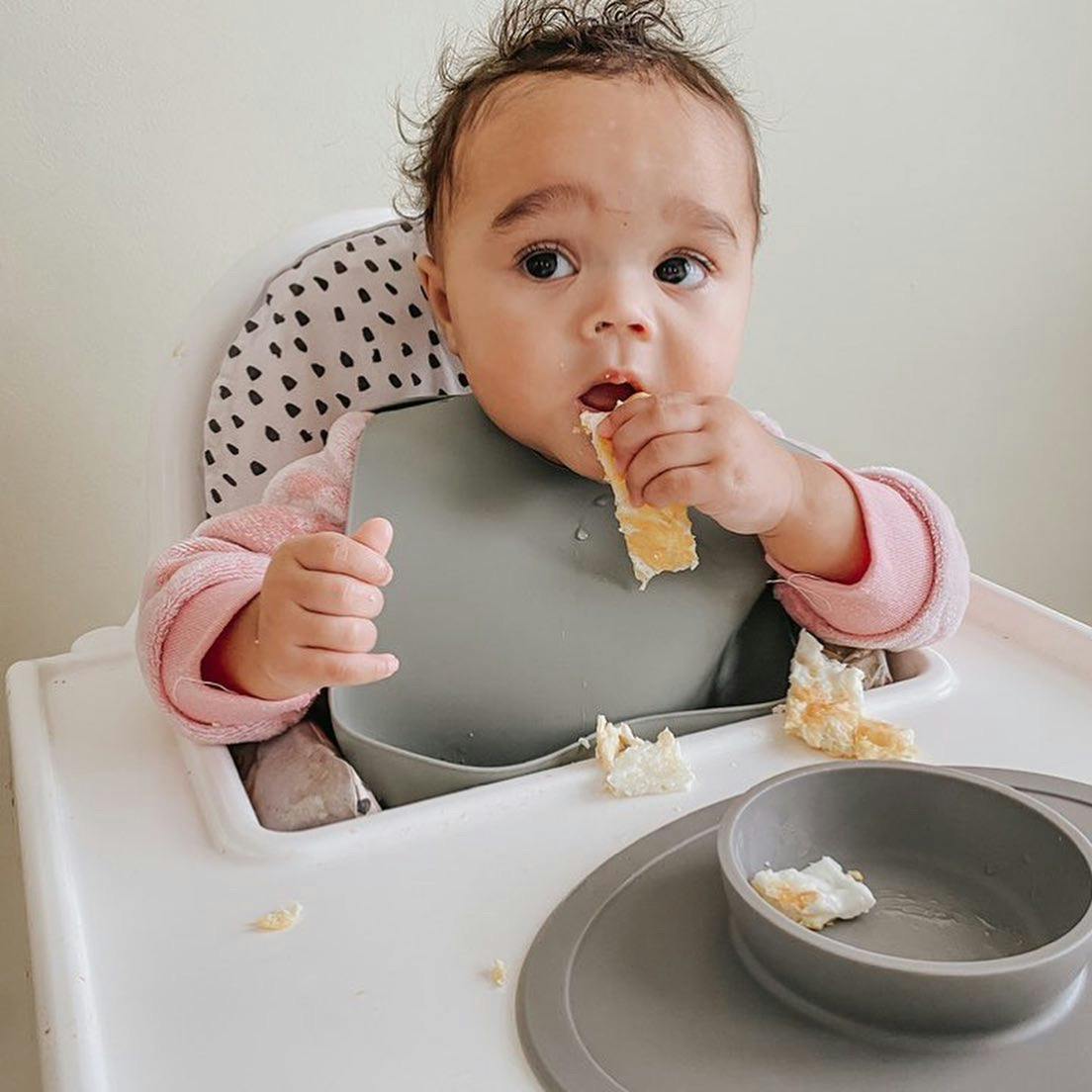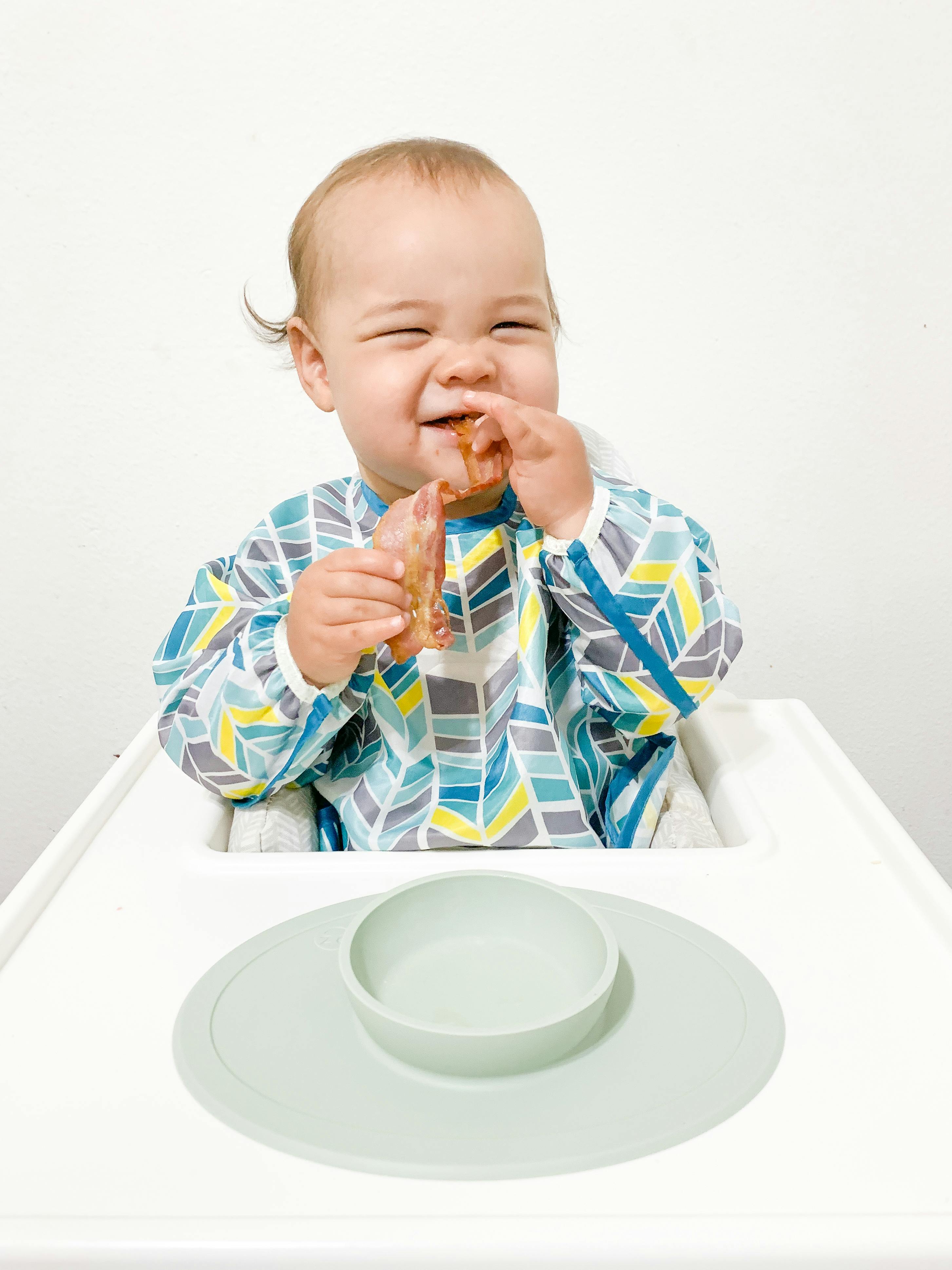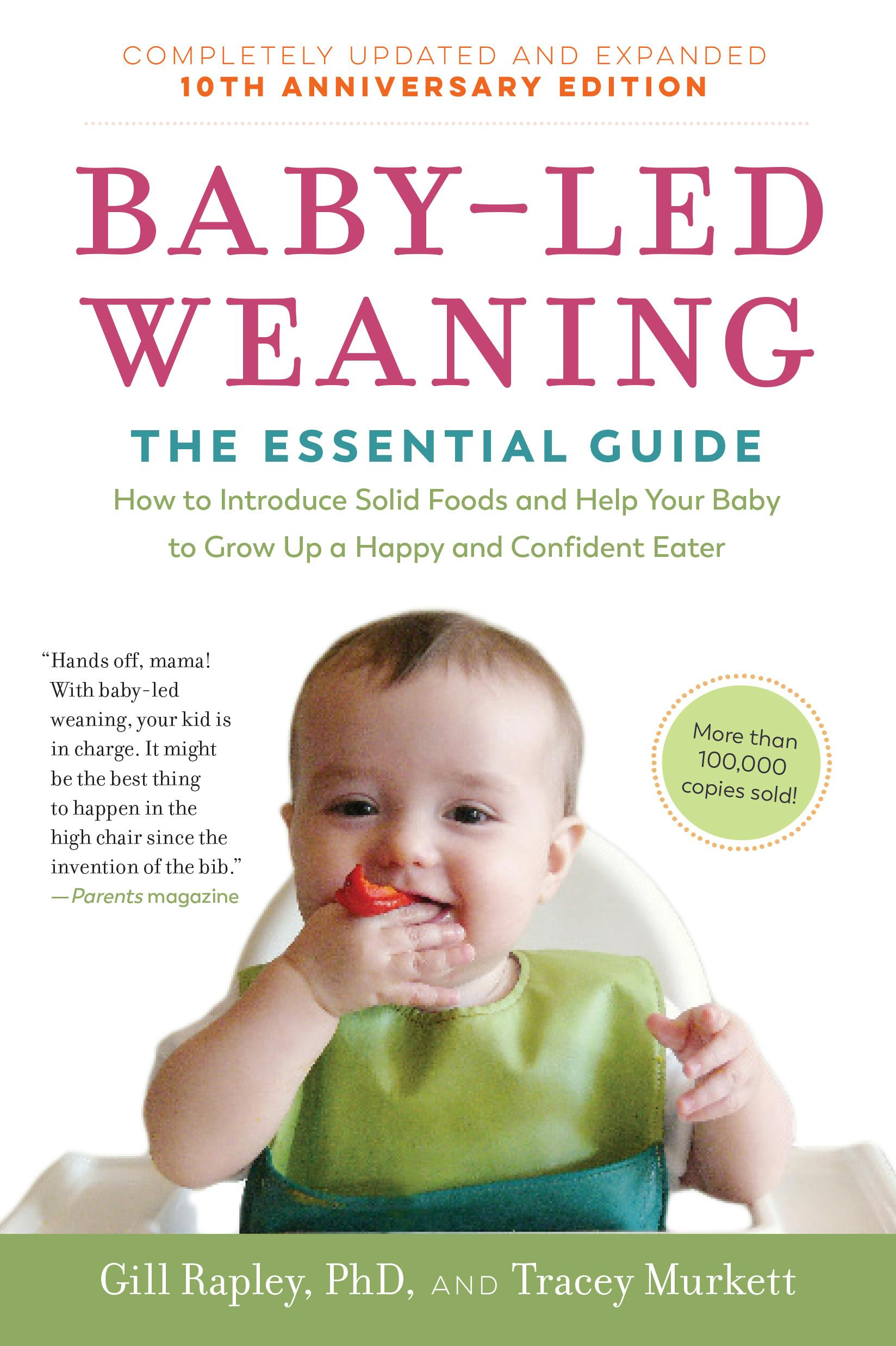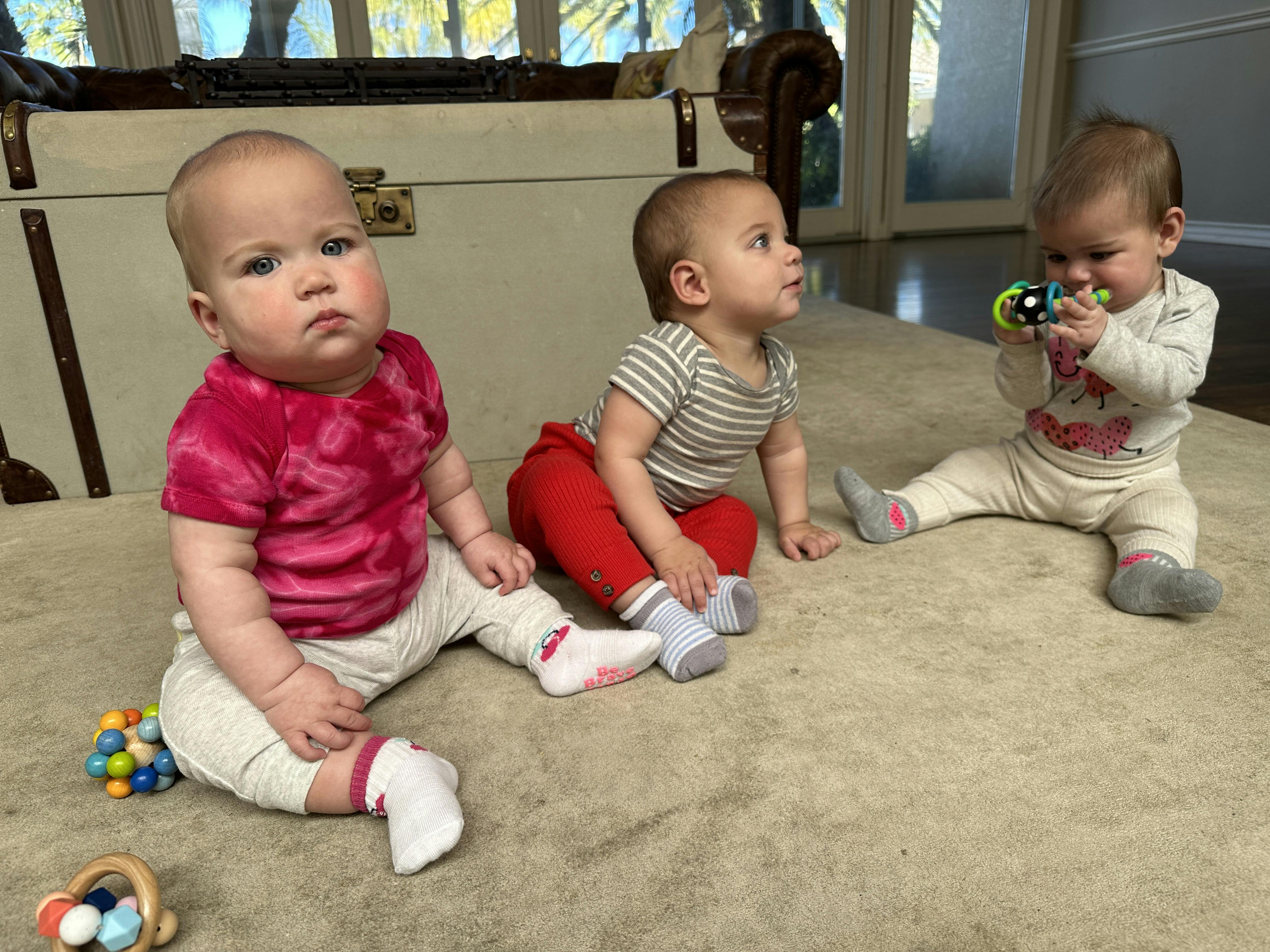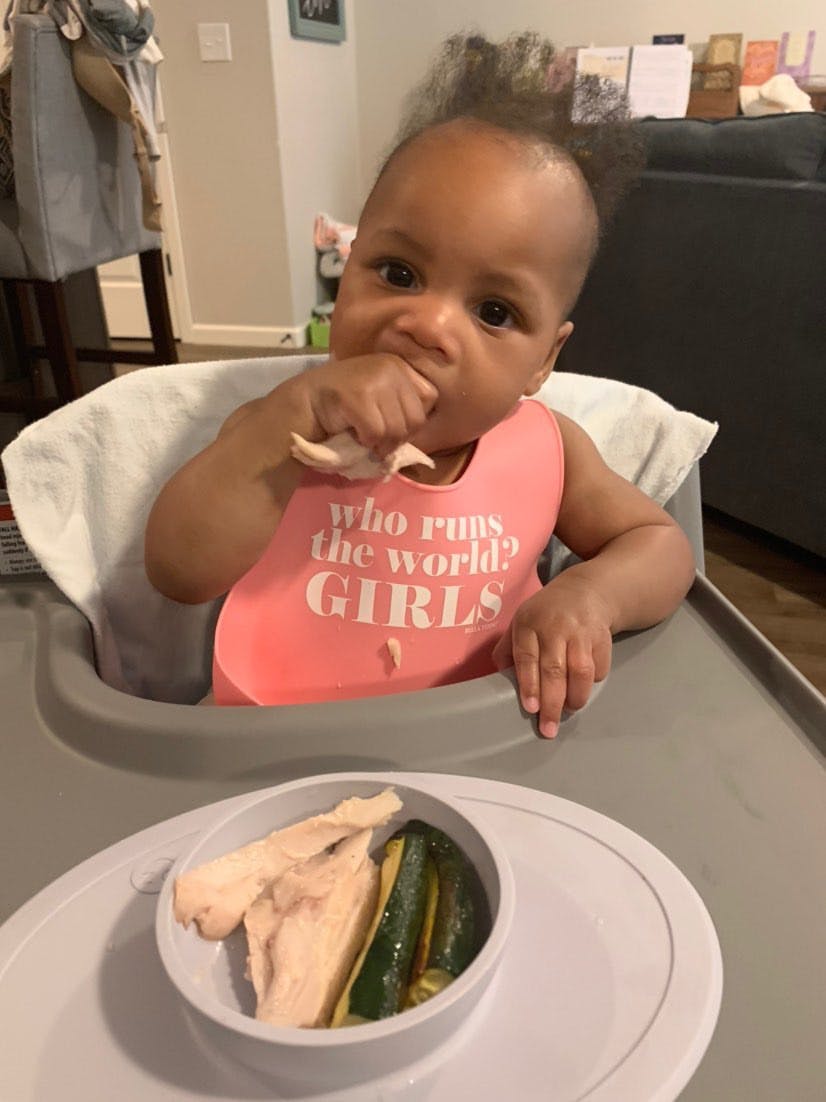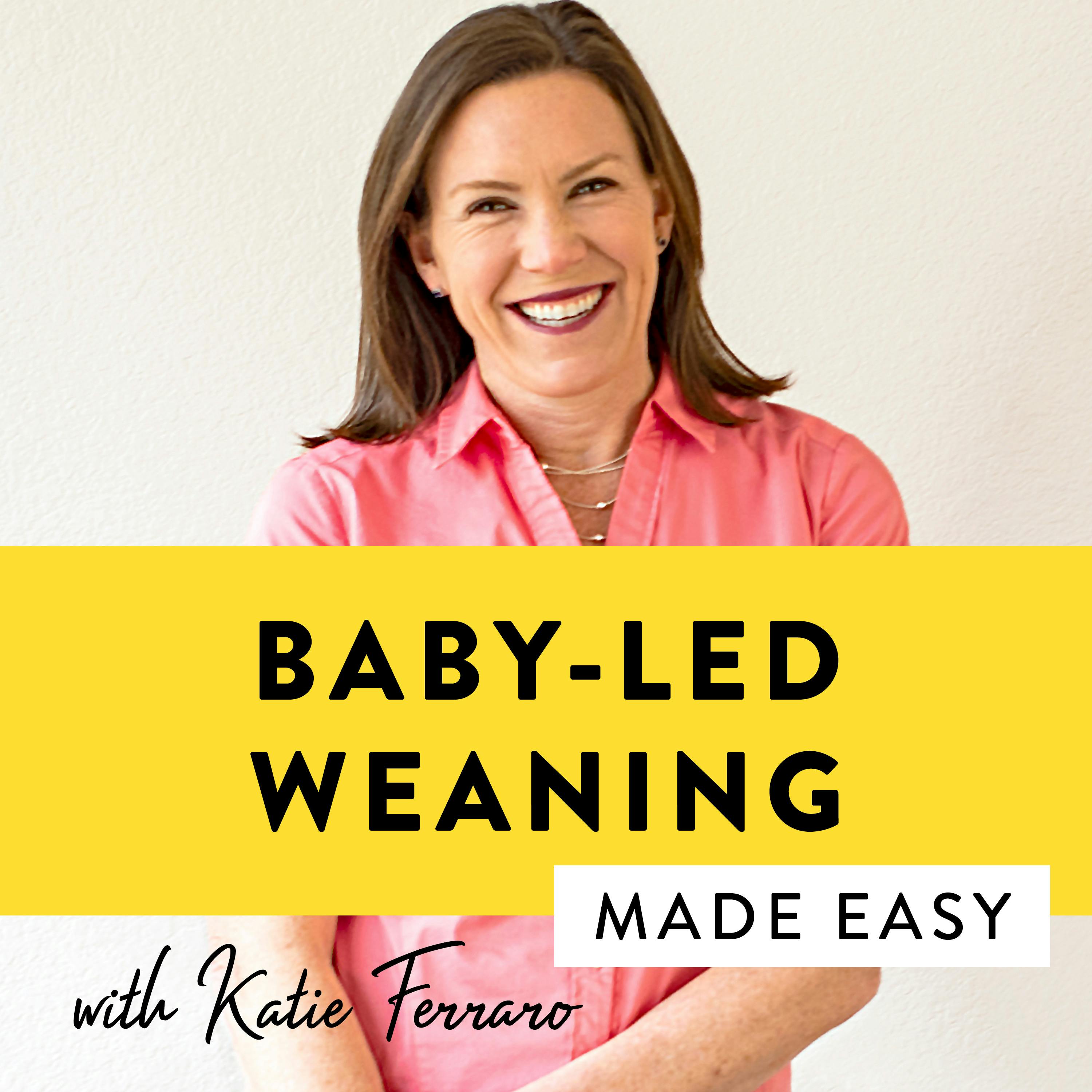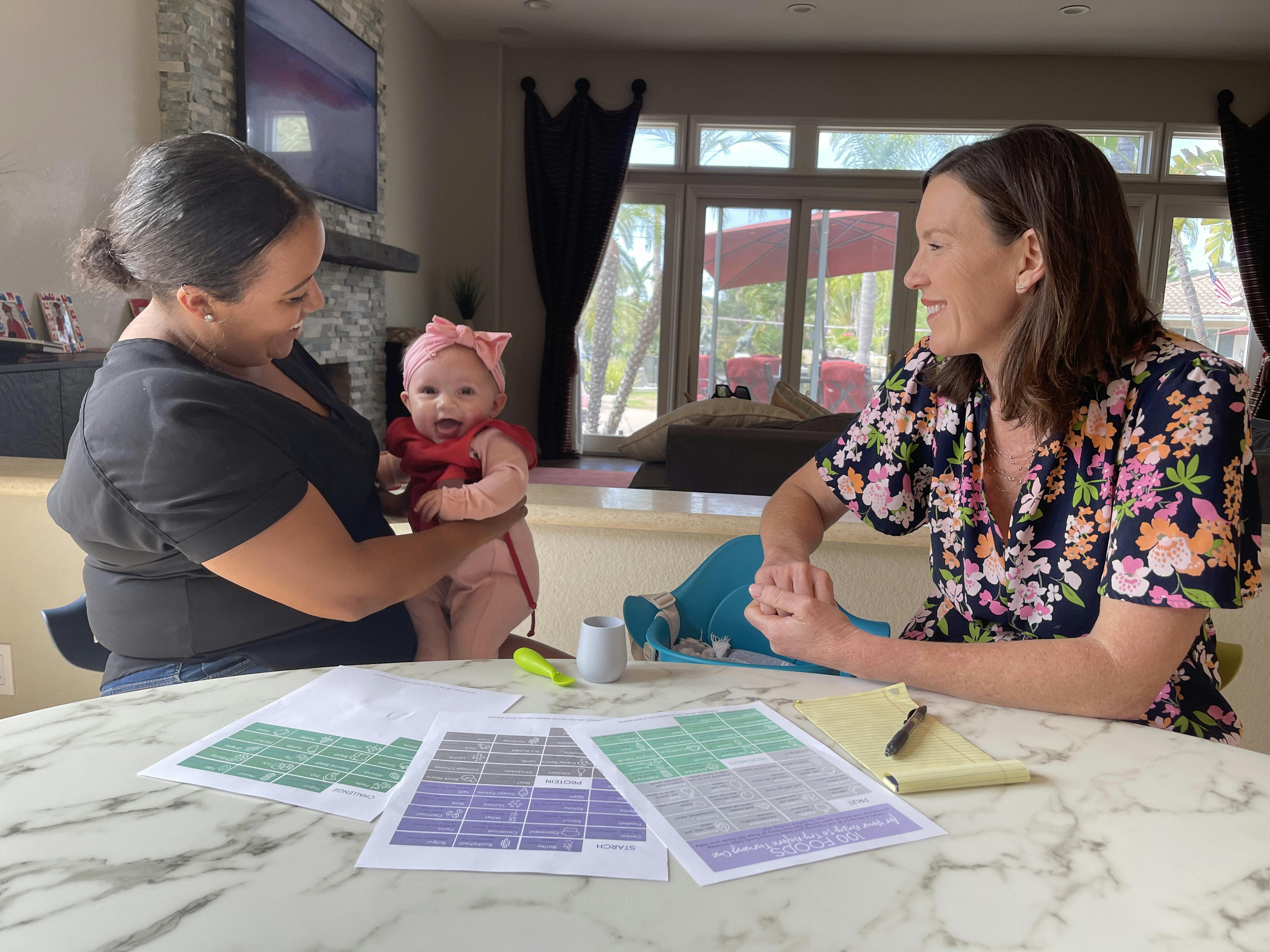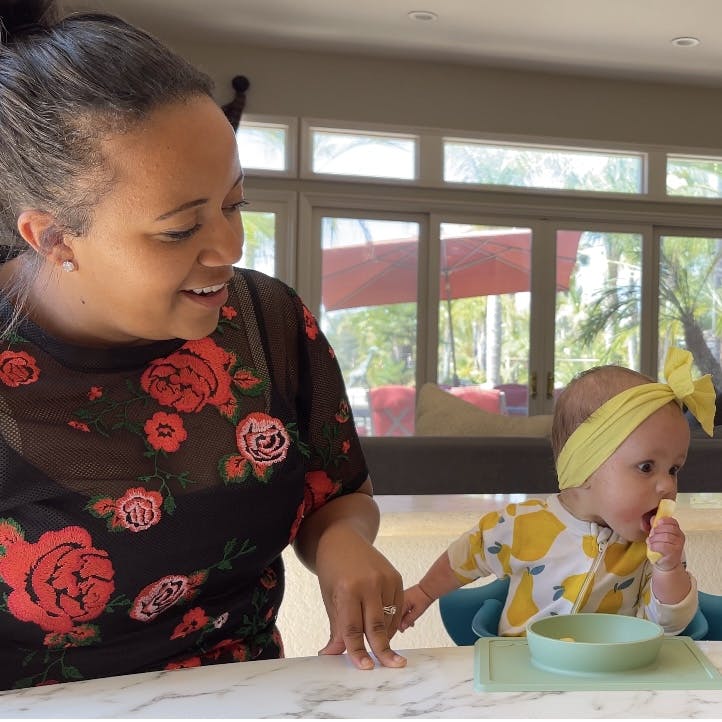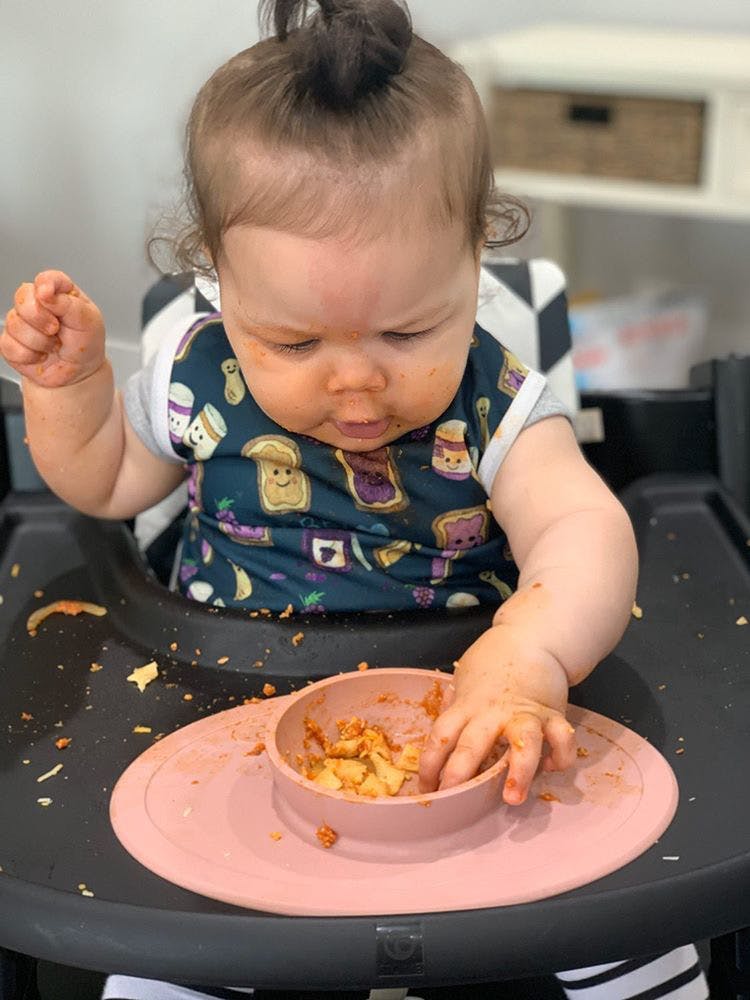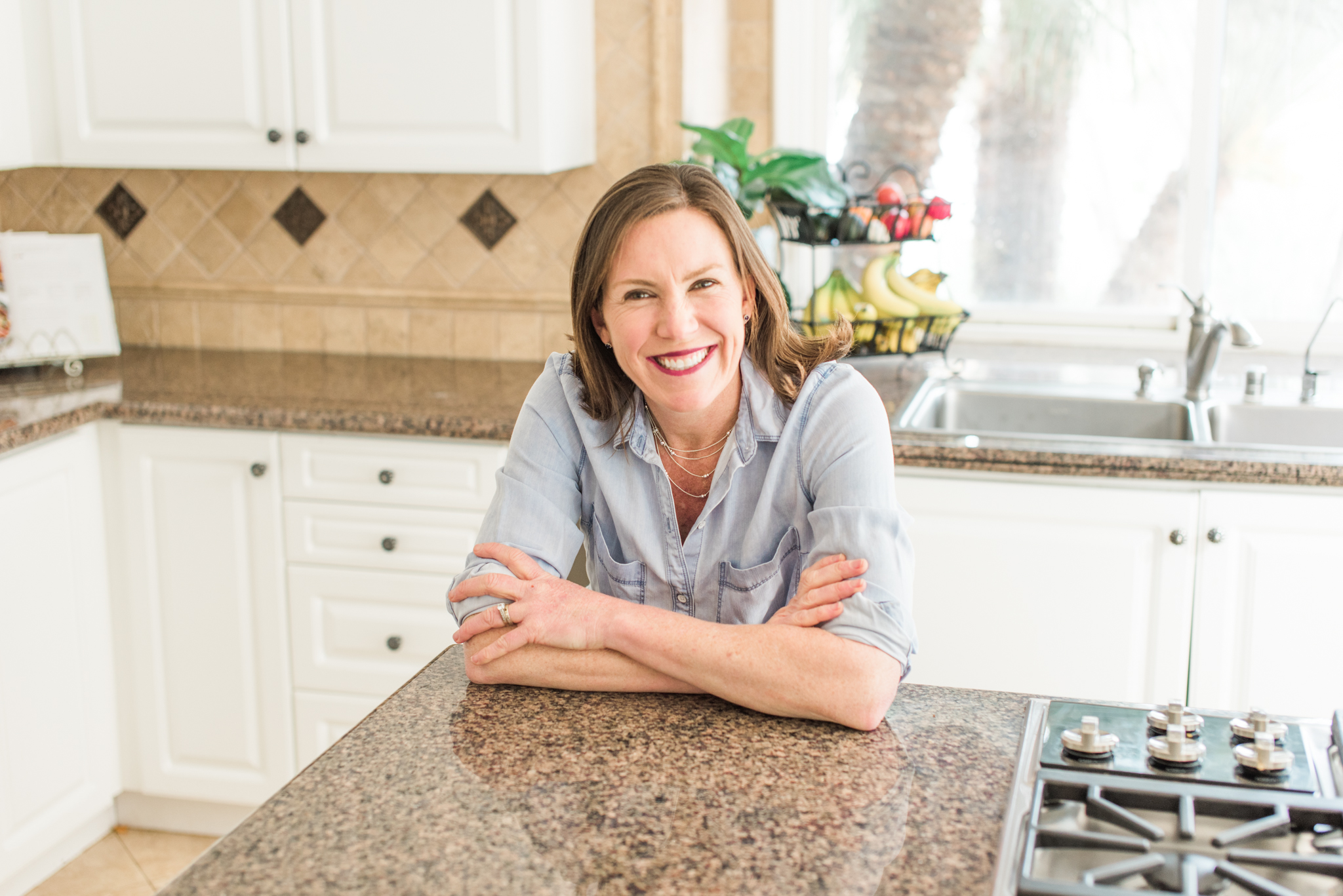Maybe you’ve been hearing a bit about baby-led weaning and you’re wondering, “What is baby-led weaning?” or “Will baby-led weaning work for my baby?” In this article I’ll answer your questions about starting solid foods using baby-led weaning so you can decide whether or not this approach is for you.
Baby Brown feeding herself a strip of fried egg, a potentially allergenic food.
What is Baby-Led Weaning?
Baby-led weaning is an alternative to conventional adult-led spoon feeding whereby babies learn to feed themselves wholesome, safe foods offered by parents and caregivers. It is a responsive feeding method that supports the baby’s inborn ability and desire to be an active participant in the transition to solid foods.
Responsive feeding methods are feeding methods wherein parents and caregivers are observing for and responding to the baby’s internal hunger and fullness cues. Just like your baby turns their head away from the bottle or the breast to tell you they don’t want to eat anymore, babies also can control their intake when they start solid foods and they do not need adults to force feed foods for them by spoon.
Ollie - 11 months, celebrating his 100th food, bacon.
Who Started Baby-Led Weaning?
The baby-led weaning movement was started by Gill Rapley, PhD, a British health visitor and co-author of the original baby-led weaning book, first published in 2008. Rapley advocated for waiting until babies are 6 months of age and are demonstrating the other reliable signs of readiness to eat before starting solid foods. This was in stark contrast to earlier practices that advocated starting solid foods at - or sometimes even before - 4 months of age.
If you haven’t read the original Baby-Led Weaning book by Gill Rapley and Tracey Murkett, it does a very good job of explaining what baby-led weaning is as a philosophy and a feeding practice and how it differs from conventional adult-led spoon feeding. Here is a link to Rapley’s original baby-led weaning book on Amazon (this is an affiliate link).
Gill Rapley, PhD co-authored the original baby-led weaning book
“Baby-led weaning is about the feeding being done by the baby…not to the baby.”
-Gill Rapley, PhD
How Does Baby-Led Weaning Differ from Spoon Feeding?
Baby-led weaning differs from conventional adult-led spoon feeding in that with the baby-led approach the baby is the one guiding the eating experience. Baby-led weaning does not mean skipping purees. Purees are an important texture for babies to master…they’re just not the only texture that babies can eat.
Sonam - 8 months, self-feeding traditional Newari food.
At What Age Can You Start Baby-Led Weaning?
In 2003, the World Health Organization changed their infant feeding recommendations to start solid foods at 6 months of age instead of 4. Compared to 4- or 5- month old babies, 6-month-old babies can sit on their own, safely swallow foods other than infant milk, and are more engaged and active participants in the feeding process, thereby eliminating the need to be spoon-fed by adults.
Infant milk is sufficient to meet your baby’s needs for the first 6 months of life and infant milk includes breastmilk and/or formula. Prior to 6 months of age, additional outside nutrition other than infant milk is not required. There are no benefits to starting solid foods prior to 6 months as babies do not nutritionally need anything other than infant milk and starting too early may increase the risk of choking as the baby is not physiologically ready or capable yet of swallowing anything except infant milk.
Infant milk meets baby’s needs up until 6 months.
How Do You Know if Your Baby is Ready to Start Baby-Led Weaning?
There are a number of telltale, reliable signs of readiness to eat. Your baby should be 6 months of age (or 6 months adjusted age if born prematurely) and able to sit relatively on their own.
The ability to sit relatively unassisted is an important indicator of the baby’s trunk strength and head control. Having adequate trunk strength and head control facilitates the safe swallow of solid foods other than infant milk. Most babies are able to sit relatively on their own somewhere around or just after the 6 month mark. Not all babies will sit right at 6 months and some babies will be 6 months + 1 week or 6 months + 2 weeks or 6 months + 3 weeks before sitting relatively on their own, and that is typical.
Triplets Lorelai, Theodore and Everly - sitting at 7 months adjusted age.
What are the Benefits of Baby-Led Weaning?
While baby-led weaning is a relatively new term and parenting phenomenon, the baby-led weaning approach and philosophy is millenia old. Different cultures and ethnic groups around the world have historically offered and continue to offer their babies modified versions of the same foods the rest of the family eats. Contrast that with commercial baby food, a largely Western invention that has only been available and marketed since the earlier part of the twentieth century.
With this feeding method, the focus is on allowing the baby to learn how to eat, with less emphasis and pressure on how much the baby is consuming. The benefits of baby-led weaning include:
- Increased feeding autonomy and participation in family meals from the baby’s first bites
- Reduced risk of selective (i.e., “picky”) eating later in toddlerhood
- Decreased risk of food allergies due to earlier exposure of potentially allergenic foods
With the baby-led approach, babies learn to recognize and respond to their inborn hunger and satiety cues.
Baby Vivi at 6 months trying chicken and asparagus
Does Baby-Led Weaning Work for All Babies?
All babies deserve the right to learn how to eat on their own. Babies who are 6 months of age (or 6 months adjusted age if born prematurely) and demonstrating the reliable signs of readiness to eat can begin to safely learn how to self-feed soft, age appropriate foods.
Older, outdated resources may list conditions or diagnoses which preclude babies from attempting baby-led weaning. Current practices indicate that almost all babies have an innate ability and desire to self-feed.
For babies with developmental delays, see the Adapted Baby-Led Weaning Approach (ABLW) created by feeding therapist Jill Rabin, MS, CCC-SLP who also co-wrote the Adapted Baby-Led Weaning book with Gill Rapley, PhD.
While the timeline for self-feeding mastery may look different for babies with certain medical conditions or diagnoses, with the exception of exclusively tube-fed babies, almost all babies can learn to safely self-feed.
- Down Syndrome BLW Success Stories with @ableappetites Sabrina Smiley Evans, MS, CCC-SLP
- How Cleft Lip & Cleft Palate Babies can Succeed in Self-Feeding with Vikash K. Modi, MD
- Tongue Ties & Lip Ties: Do These Affect Baby's Ability to Self-Feed with Shaina Holman, DDS, PhD
What Foods Do You Offer with Baby-Led Weaning?
Babies can eat so many more foods than we give them credit for!
While conventional adult-led spoon feeding is limited to a small number of commercially or home-produced pureed foods, with the baby-led weaning approach, the number and types of foods that babies can safely learn to eat is almost infinite!
In 2016 I created the original 100 FIRST FOODS™ approach to starting solid foods with baby-led weaning. Using my 5-STEP FEEDING FRAMEWORK™ we introduce 5 new foods each week to the baby:
- 1 new fruit on Monday
- 1 new vegetable on Tuesday
- 1 new starchy food on Wednesday
- 1 new protein food on Thursday
- 1 new allergenic food on Friday
It is perfectly safe to introduce 1 (or more) new food every day to your baby. With 5 new foods per week, you try 20 new foods per month and in just 5 months, your baby has had 100 different foods before turning 1. This approach takes the guesswork out of which foods to offer your baby next.
To learn more about how to give your baby a safe start to solid foods and to grab a copy of my original 100 FIRST FOODS LIST, register for the free online video workshop called BABY-LED WEANING FOR BEGINNERS.
Inside of this workshop you will learn:
- How to know if your baby is really ready to start...so you don't start too soon which increases choking risk
- How to safely prepare food for the first 10 days...including high iron foods like meat which can be tricky
- How to introduce allergenic foods to help lower food allergy risk...and what to do if your baby has an allergic reaction
Click here to register for the free BABY-LED WEANING FOR BEGINNERS workshop and grab your copy of my original 100 FIRST FOODS list on this training too.
Brayden - 6 months, preparing to start 100 new foods.
How Do You Prepare and Serve Foods for Baby-Led Weaning?
From a developmental standpoint, 6-month old babies can pick up larger pieces of food and safely self-feed. In the earlier part of the weaning period (6-9 months of age), babies use their whole hand or palmar grasp to rake and scoop pieces of food up and into their mouth.
Baby-led weaning foods are generally offered as soft pieces of food shaped about the size of an adult pinky finger. Older babies (9-12 months of age) will have developed their pincer grasp which eventually allows them to safely self-feed smaller pieces of food.
Brayden - 6 months, learning to eat egg
Is Baby-Led Weaning Safe?
Infant milk (breastmilk and/or commercial infant formula) will continue to be a primary source of nutrition during the weaning period. Babies who start solid foods with a baby-led approach are at no higher risk of choking than are conventionally spoon-fed babies, provided that parents and caregivers are educated about reducing choking risks. Baby-led weaning babies are not at risk for growth faltering and they are able to meet their overall iron and nutrient needs.
Baby-led weaning researcher Amy Brown, PhD wrote a very informative review article about the research that supports baby-led weaning called “Baby-Led Weaning: The Evidence to Date” and you can read that here.
READ BLW RESEARCH REVIEW ARTICLE
Does Baby-Led Weaning Help Prevent Picky Eating?
There is no surefire way to prevent picky eating. In fact, picky eating is a developmentally appropriate phase for toddlers to go through. While baby-led weaning does not prevent picky eating, it does have the potential to reduce the risk and severity of picky eating.
Almost all babies will develop some form of picky eating of food neophobia (fear of new foods) beginning in the second year of life. With conventional adult-led spoon feeding your baby might eat only 10 or 15 different foods by the time they turn one…and if you lose those 10 or 15 foods to picky eating, that becomes a very challenging baby to feed.
But with my 100 FIRST FOODS approach to baby-led weaning, your baby learns to safely eat 100 foods before turning one…so that if you lose 10 or 15 of those foods to picky eating in the second year of life, it’s not a big deal because you still have 85 or 90 foods that your baby will eat.
To get your free copy of my 100 FIRST FOODS list, register for the free BABY-LED WEANING FOR BEGINNERS workshop here.
Violeta, 10 months old celebrating her 100th First Food (lamb)
How Does Baby-Led Weaning Support the Development of Fine
Motor Skills?
Learning how to eat is a full sensory experience. With this approach it is important to allow your baby to have ample time and practice to learn how to eat. The focus is not on HOW MUCH the baby is eating, but rather allotting time so the baby can learn HOW to eat.
When babies start eating solid foods they do not have their pincer grasp. Instead, the baby uses their whole hand - or palmar grasp - to rake and scoop foods up and into their mouth. The foods offered early in baby-led weaning are soft, solid pieces of food about the size of your adult pinky finger. With time, older babies develop their pincer grasp and they can then learn to pick up and safely self-feed smaller pieces of food.
Baby-led weaning helps your baby fine-tune their motor skills
What are the Potential Risks or Drawbacks with Baby-Led Weaning?
Making the transition to solid foods can be a challenging and stressful time for parents and caregivers. While it might be scary to watch your baby learn how to eat solid foods, there is no higher risk of choking with baby-led weaning compared to conventional adult-led spoon feeding.
Babies who start solid foods with a baby-led approach are at no higher risk of choking than are conventionally spoon-fed babies, provided that parents and caregivers are educated about reducing choking risks. Baby-led weaning babies are not at risk for growth faltering and they are able to meet their overall iron and nutrient needs.
Parents and caregivers may be apprehensive about this approach to starting solid foods because it is messy; however, baby-led weaning advocates maintain that learning how to eat is a full sensory experience. Giving babies ample time and experiences to explore food is more important than focusing on how much the baby is eating early on.
Aria, 7 months enjoying learning how to eat yogurt
Where Can I Go to Learn More About Baby-Led Weaning?
If you are interested in learning more about baby-led weaning, it is important to get information from a trusted and reliable, credentialed infant feeding expert.
Registered Dietitians who specialize in infant feeding as well as Occupational and/or Speech and Language Pathologists who are also specialized in infant feeding and are feeding therapists are wonderful resources for new parents.
As a Registered Dietitian specializing in baby-led weaning, I have a number of additional learning resources for you to learn more:
- The Baby-Led Weaning Made Easy podcast features short baby-led weaning training episodes as well as interviews with leading feeding experts from around the world.
FOLLOW THE BLW PODCAST ON YOUR DEVICE
- The Baby-Led Weaning YouTube channel contains videos that show you how to safely prepare solid foods for your baby as well as instructions about lowering choking risk.
SUBSCRIBE TO THE BLW YOUTUBE CHANNEL
- The @babyledweanteam Instagram page is the largest community dedicated solely to baby-led weaning.
FOLLOW @babyledweanteam ON INSTAGRAM
- The free video workshop BABY-LED WEANING FOR BEGINNERS is a great place to get started learning about this approach and how to do it safely. The free workshop is 75 minutes long and everyone who registers receives a free copy of my original 100 FIRST FOODS list
REGISTER FOR FREE BLW WORKSHOP
- The BABY-LED WEANING with Katie Ferraro digital program is a step-by-step blueprint for exactly how to introduce all of the 100 FIRST FOODS to your baby with guided instruction by Katie.
JOIN KATIE’S 100 FIRST FOODS BLW PROGRAM
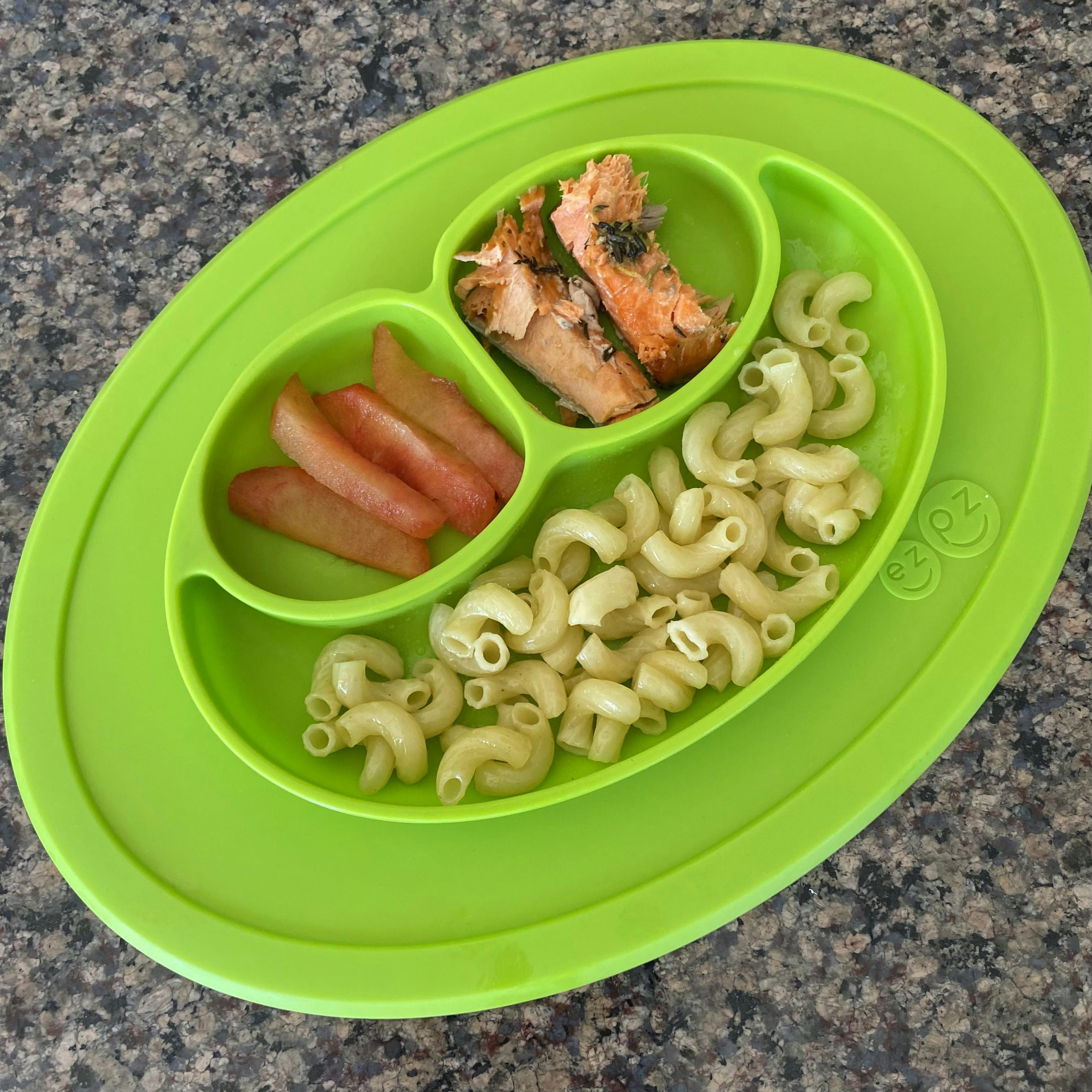
Offering your baby a variety of foods helps increase diet diversity
ABOUT THE AUTHOR
Katie Ferraro, MPH, RDN is a registered dietitian, college nutrition professor and mom of 7. She specializes in baby-led weaning and is the creator of the original 100 FIRST FOODS™ program. Katie hosts the top-rated parenting podcast BABY-LED WEANING MADE EASY and runs the baby-led weaning YouTube channel and @babyledweanteam Instagram account. Her BABY-LED WEANING with Katie Ferrao digital program is the go to resource for exactly how to start solid foods safely with baby-led weaning and to help your baby eat 100 safe, baby-led weaning foods before turning one.
REFERENCES
Rapley, G & Muurkett, T. Baby-Led Weaning The Essential Guide. New York, The Experiment, 2019.
World Health Organization. “Infant and young child feeding.” Factsheets, 9 June 2021. https://www.who.int/news-room/fact-sheets/detail/infant-and-young-child-feeding
Bentley, A. Inventing Baby Food: Taste, Health, and the Industrialization of the American Diet. Oakland, CA, University of California Press, 2014.
Morison, B. J., Heath, A. M., Haszard, J. J., Hein, K., Fleming, E. A., Daniels, L., Erickson, E. W., Fangupo, L. J., Wheeler, B. J., Taylor, B. J., & Taylor, R. W. (2018). Impact of a Modified Version of Baby-Led Weaning on Dietary Variety and Food Preferences in Infants. Nutrients, 10(8), 1092. https://doi.org/10.3390/nu10081092
Rowan, H., Lee, M., & Brown, A. (2019). Differences in dietary composition between infants introduced to complementary foods using Baby-led weaning and traditional spoon feeding. Journal of human nutrition and dietetics : the official journal of the British Dietetic Association, 32(1), 11–20. https://doi.org/10.1111/jhn.12616
Taylor, R. W., Williams, S. M., Fangupo, L. J., Wheeler, B. J., Taylor, B. J., Daniels, L., Fleming, E. A., McArthur, J., Morison, B., Erickson, L. W., Davies, R. S., Bacchus, S., Cameron, S. L., & Heath, A. M. (2017). Effect of a Baby-Led Approach to Complementary Feeding on Infant Growth and Overweight: A Randomized Clinical Trial. JAMA pediatrics, 171(9), 838–846. https://doi.org/10.1001/jamapediatrics.2017.1284
Brown A. (2018). No difference in self-reported frequency of choking between infants introduced to solid foods using a baby-led weaning or traditional spoon-feeding approach. Journal of human nutrition and dietetics : the official journal of the British Dietetic Association, 31(4), 496–504. https://doi.org/10.1111/jhn.12528
Cameron, S. L., Taylor, R. W., & Heath, A. L. (2015). Development and pilot testing of Baby-Led Introduction to SolidS--a version of Baby-Led Weaning modified to address concerns about iron deficiency, growth faltering and choking. BMC pediatrics, 15, 99. https://doi.org/10.1186/s12887-015-0422-8
Daniels, L., Taylor, R. W., Williams, S. M., Gibson, R. S., Samman, S., Wheeler, B. J., Taylor, B. J., Fleming, E. A., Hartley, N. K., & Heath, A. M. (2018). Modified Version of Baby-Led Weaning Does Not Result in Lower Zinc Intake or Status in Infants: A Randomized Controlled Trial. Journal of the Academy of Nutrition and Dietetics, 118(6), 1006–1016.e1. https://doi-org.libproxy.sdsu.edu/10.1016/j.jand.2018.02.005
Fangupo, L. J., Heath, A. M., Williams, S. M., Erickson Williams, L. W., Morison, B. J., Fleming, E. A., Taylor, B. J., Wheeler, B. J., & Taylor, R. W. (2016). A Baby-Led Approach to Eating Solids and Risk of Choking. Pediatrics, 138(4), e20160772. https://doi.org/10.1542/peds.2016-0772
